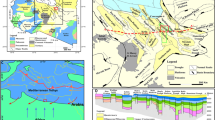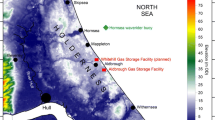Abstract
Alluvial fan is a depositional fluvial landform that is characterised by sediment flow and hydrological processes and is also controlled by tectonic activity. These extraordinary features have always attracted researchers since the past as they preserve the past records, but now, this study is focused on the formation meso-level fans with its spatio-temporal dynamic nature. These tributaries have formed secondary alluvial fans at their debouching points. The dynamics of the fans are controlled by the hydrological responses and tectonic base and also by the sedimentation processes. The origin of these tributaries and their respective fans are related to the last stage of Himalayan uplift. This is the region of Himalayan foreland basin which contains the main frontal thrust and makes the region tectonically very active. The region is drained by many large rivers and their numerous tributaries. The active tectonism, the configuration of the basin and also the deposition of the sediments carried by these rivers have formed alluvial fans where the channel debouches into the widened valley. In the present study, the meso-level alluvial fans formed by River Gish and the Rivers Neora and Murti have been studied. Both these fans are present in the piedmont region of the Himalayas, but they deliver different characteristics, and the nature of their deposition is also different. This is mainly because of the influence of the minor faults in the region which control the channel pattern and also have a great influence in the sediment delivery to the downstream section of the channels. Thus, in order to understand the influence of tectonics in the dynamics of these fans, some morphotectonic parameters have been taken into consideration. These include mountain front sinuosity index, valley floor width-to-depth ratio, and tectonic tilt. The calculated hypsometric integral also depicts that the two fans are at different stages of development.












Similar content being viewed by others
References
Acharya SK (1971) A note on the nature of Daling- Darjeeling relation, Darjeeling hills. Ind Miner 25(3):254–255
Banerjee T (1955) Continuation of geological mapping in Sikkim and Kalimpong Hills. Progress Report, Geological Survey of India
Bisaria BK (1980) Report on geomorphological mapping of a part of the foothills of Darjeeling Himalayas, West Bengal, Geological survey of India report, 1–16 pp
Bishop P, Young RW, Mcdougall I (1985) Stream profile change and longterm landscape evolution: early Miocene and modern rivers of the east Australian highland crest, Central New South Wales, Australia. J Geol 93:455–474
Burbank DW, Beck RA, Mulder T (1996) The Himalayan foreland basin. Cambridge University Press, Cambridge, pp 149–188
Burbank DW, Anderson RS (2001) Tectonic geomorphology, Blackwell Publishing, 350 Main Street, Malden, MA 02148–5020, USA, 1–287 pp
Bookhagen B, Thiede RC, Strecker MR (2005) Late Quaternary intensified monsoon phases control landscape evolution in the northwest Himalaya. Geology 33(2):149–152. https://doi.org/10.1130/G20982.1
Bookhagen B, Fleitmann D, Nishiizumi K, Strecker MR, Thiede RC (2006) Holocene monsoonal dynamics and fluvial terrace formation in the northwest Himalaya, India. Geology 34(7):601–604. https://doi.org/10.1130/G22698.1
Bull WB (1977) The alluvial fan environment. Prog Phys Geogr 1(2):222–270. https://doi.org/10.1177/030913337700100202
Chakraborty T, Ghosh P (2010) The geomorphology and sedimentology of the Tista megafan, Darjeeling Himalaya:implications for megafan building processes. Geomorphology 115:252–266
DeCelles, P.G., Gehrels, G.E., Quade, J., Kapp, P.A., Ojha, T.P., and Upreti, B.N., 1998, Neogene foreland basin deposits, erosional unroofing, and the kinematic history of the Himalayan fold-thrust belt, western Nepal: Geol Soc Am Bull, v. 110, p. 2–21, 1, DOI: https://doi.org/10.1130/0016-7606(1998)110<0002:NFBDEU>2.3.CO;2
Einsele G, Ratschbacher L, Wetzel A (1996) The Himalaya–Bengal Fan denudation–accumulation system during the past 20 Ma. J Geol 104(2):163–184. https://doi.org/10.1086/629812
Fontana A, Mozzi P, Bondesan A (2008) Alluvial megafans in the Venetian–Friulian plain (north-eastern Italy): evidence of sedimentary and erosive phases
Fraser GS, DeCelles PG (1992) Geomorphic controls on sediment accumulation at margins of foreland basins. Basin Res 4(3-4):233–252. https://doi.org/10.1111/j.1365-2117.1992.tb00047.x
Gohain K, Prakash B (1990) Morphology of the Kosi Megafan. In: Rachoki A, Church M (eds) Alluvial fans: a field approach. John Willey and Sons Ltd, Chichester, pp 151–178
Gansser A (1964) Geology of the Himalayas. Interscience Publishers, London etc. (JWiley & Sons), pp. 1–289
Gibling MR, Tandon SK, Sinha R, Jain M (2005) Discontinuity-bounded alluvial sequences of the southern Gangetic Plains, India: aggradation and degradation in response to monsoonal strength. J Sediment Res 75(3):369–385. https://doi.org/10.2110/jsr.2005.029
Goswami C, Mukhopadhyay D, Poddar BC (2012) Tectonic control on the drainage system in a piedmont region in tectonically active eastern Himalayas. Front Earth Sci 6(1):29–38. https://doi.org/10.1007/s11707-012-0297-z
Guha D, Bardhan S, Basir SR, De AK, Sarkar A (2007) Imprints of Himalayan thrust tectonics on the Quaternary piedmont sediments of the Neora–Jaldhaka Valley, Darjeeling–Sikkim sub-Himalayas, India. J Asian Earth Sci 30(3-4):464–473. https://doi.org/10.1016/j.jseaes.2006.11.010
Gupta S (1997) Himalayan drainage patterns and the origin of fluvial megafans in the Ganges foreland basin. Geology 25(1):11–14. https://doi.org/10.1130/0091-7613(1997)025<0011:HDPATO>2.3.CO;2
Hack JT (1957) Studies of longitudinal stream profile in Virginia and Maryland. US Geol Survey Prof Paper 294-B:45–95
Horton BK, DeCelles PG (2001a) Modern and ancient fluvial megafans in the foreland basin systems of the central Andes, southern Bolivia: implication for drainage network evolution in fold-thrust belts. Basin Res 13(1):43–61. https://doi.org/10.1046/j.1365-2117.2001.00137.x
Horton, B.K., and DeCelles, P.G., 2001b. Modern and ancient fluvial megafans in the foreland basin system of the central Andes, southern Bolivia: Implications for drainage network evolution in fold-thrust belts: Basin Res, v. 13, p. 43–61
Harvey AM (2005) Differential effects of base-level, tectonic setting and climatic change on quaternary alluvial fans in the northern Great Basin, Nevada, USA. In: Harvey AM, Mather AE, Stokes M (Eds) Alluvial fans: geomorphology, sedimentology, dynamics. Geol Soc Spec Publ, pp. 117–131, 251, 1, doi:https://doi.org/10.1144/GSL.SP.2005.251.01.09
Harvey AM, Mather AE, Stokes M (2005) Introduction. A review of alluvial-fan research. In: Harvey AM, Mather AE, Stokes M (Eds) Alluvial fans: geomorphology, sedimentology, dynamics. Geol Soc Spec Publ, 251, 1–7, Alluvial fans: geomorphology, sedimentology, dynamics — introduction. A review of alluvial-fan research, 1, doi:https://doi.org/10.1144/GSL.SP.2005.251.01.01
Hodges KV (2000) Tectonics of Himalaya and southern Tibet from two perspectives. Geol Soc Am Bull 112(3):324–350. https://doi.org/10.1130/0016-7606(2000)112<324:TOTHAS>2.0.CO;2
Jones SJ, Arzani N, Allen MB (2014) Tectonic and climatic controls on fan systems: the Kohrud Mountain Belt, Central Iran. Sediment Geol 302:29–43. https://doi.org/10.1016/j.sedgeo.2013.12.008
Kar R, Chakraborty T (2014) Comment on “Geomorphology in relation to tectonics: a case study from the eastern Himalayan foothill of West Bengal, India2014
Kar K, Chakraborty T, Chakraborty C, Ghosh P, Tyagi AK, Singhvi AK (2014) Morpho-sedimentary characteristics of the quaternary Matiali fan and associated river terraces, Jalpaiguri, India: implications for climatic controls. Geomorphology 227:137–152
Keller EA, Pinter N (1996) Active tectonics: earthquakes, uplift and landscape. Prentice Hall, New Jersey 338 p
Kumar R (1993) Coalescence megafan: multistorey sandstone complex of late orogenic (Mio-Pliocene) sub-Himalayan belt, Dehra Dun, India. Sediment Geol 85(1-4):327–337. https://doi.org/10.1016/0037-0738(93)90091-I
Kumar S, Wesnousky SG, Rockwell TK, Briggs RW, Thakur VC, Jayangonda PR (2006) Paleoseismic evidence of great surface rupture earthquakes along Indian Himalaya. J Geophys Res 111:B03304 https://doi.org/10.1029/2004JB003309
Kumar R, Suresh N, Sangode SJ, Kumaravel V (2007) Evolution of the quaternary alluvial fan system in the Himalayan foreland basin: implications for tectonic and climatic decoupling. Quat Int 159:6–20
Kumar S, Wesnousky SG, Jayangondaperumal R, Nakata T, Kumahara Y, Singh V (2010) Paleoseismological evidence of surface faulting along the northeastern Himalayan front, India: timing, size, and spatial extent of great earthquakes. J Geophys Res 115 https://doi.org/10.1029/2009JB006789
Lee C, Tsai LL (2009) A quantitative analysis for geomorphic indices of longitudinal river profile: a case study of the Choushui River, Central Taiwan
Leier AL, DeCelles PG, Pelletier JD (2005) Mountains, monsoons and megafans. Geology 33(4):289–292. https://doi.org/10.1130/G21228.1
Malik JN, Nakata T (2003) Active faults and related late quaternary deformation along the northwestern Himalayan Frontal Zone, India. Ann Geophys 46:917–936
Mandal S, Sarkar S (2016) Overprint of neotectonism along the course of river Chel, north Bengal, India. J Palaeogr 5(3):221–240. https://doi.org/10.1016/j.jop.2016.05.004
Meetei LI, Pattanayaka SK, Bhaskar A, Pandit MK, Tandon SK (2007) Climatic imprints in Quaternary valley fill deposits of the middle Teesta valley, Sikkim Himalaya. Quat Int 159(1):32–46. https://doi.org/10.1016/j.quaint.2006.08.018
Miall AD (1996) Geology of fluvial deposits. Springer-Verlag, Berlin, p 582
Mukhopadhyay DK, Mishra P (2004) The main frontal thrust (MFT), Northwestern Himalayas: thrust trajectory and hanging wall fold geometry from balanced cross sections. J Geol Soc India 64:739–746
Mukul M, Jade S, Ansari K, Matin A (2014) Seismotectonic implications of strike-slip earthquakes in the Darjiling–Sikkim Himalaya. Curr Sci 106:198–210
Mullick M, Riguzzi F, Mukhopadhyay D (2009) Estimates of motion and strain rates across active faults in the frontal part of eastern Himalayas in North Bengal from GPS measurements. Terra Nova 21(5):410–415. https://doi.org/10.1111/j.1365-3121.2009.00898.x
Najman Y (2006) The detrital record of orogenesis: a review of approaches and techniques used in Himalayan sedimentary basins. Earth-Sci Rev 74:1–72
Nakata T (1989) Active faults of the Himalaya of India and Nepal. Geol Soc Am Spec Pap 232:243–264. https://doi.org/10.1130/SPE232-p243
Nemec W, Postma G (1993) Quaternary alluvial fans in southwestern Crete: sedimentation processes and geomorphic evolution. In: Marzo M, Puigdefabregas C (Eds) Alluvial sedimentation: special publication International Association for Sedimentologists, 17, pp. 235–276, doi:https://doi.org/10.1002/9781444303995.ch18
Pike RJ, Wilson SE (1971) Elevation-relief ratio, hypsometric integral, and geomorphic area-altitude analysis, GSA Bulletin (1971) 82 (4): 1079–1084
Pinter N, Keller EA (1995) Geomorphological analysis of neotectonic deformation, northern Owens Valley, California. Geol Rundsch 84:200–212
Pratt B, Burbank DW, Heimsath A, Ojha T (2002) Impulsive alluviation during early Holocene strengthened monsoons, central Nepal Himalaya. Geology 30(10):911–914. https://doi.org/10.1130/0091-7613(2002)030<0911:IADEHS>2.0.CO;2
Schumm SA (1956) Evolution of drainage systems and slopes in badlands at Perth Amboy, New Jersey. Bull Geol Soc Am 67:597–646
Seeber L, Gornitz V (1983) Rivers profiles along the Himalayan arc as indicators of active tectonics. Tectonophysics, Elsevier 92(1983):335–367
Singh S, Jain AK (2007) Liquefaction and fluidization of lacustrine deposits from Lahaul-Spiti and Ladakh Himalaya: geological evidences of paleoseismicity along active fault zone. Sediment Geol 196(1-4):47–57. https://doi.org/10.1016/j.sedgeo.2006.06.005
Singh V, Tandon SK (2010) Integrated analysis of structures and landforms of an intermontane longitudinal valley (Pinjaur Dun) and its associated mountain fronts in the NW Himalaya. Geomorphology 114(4):573–589. https://doi.org/10.1016/j.geomorph.2009.09.019
Singh AK, Parkash B, Mohindra R, Thomas JV, Singhvi AK (2001) Quaternary alluvial fan sedimentation in the Dehradun Valley piggyback basin, NW Himalayas: tectonic and climatic implications. Basin Res 13:441–471
Sinha R (2009) Dyna1mics of a river system– the case of the Kosi River in North Bihar. Sedimentol e-J Earth Sci India 2(I):33–4541 825–845
Sinha R, Friend PF (1994) River systems and their sediment flux, Indo-Gangetic plains, northern Bihar, India. Sedimentology 41(4):825–845. https://doi.org/10.1111/j.1365-3091.1994.tb01426.x
Strahler AN (1952) Dynamic basis of geomorphology. Geol Soc Am Bull 63:923–938
Suresh N, Bagati TN, Kumar R, Thakur VC (2007) Evolution of Quaternary alluvial fans and terraces in the intramontane Pinjaur Dun, sub-Himalaya, NW India: interaction between tectonics and climate change. Sedimentology 54(4):809–833. https://doi.org/10.1111/j.1365-3091.2007.00861.x
Tandon SK, Sinha R, Gibling MR, Dasgupta AS, Ghazanfari P (2008) Late quaternary evolution of the Ganga Plains: myths and misconceptions, recent developments and future directions. Golden Jubilee Mem Geol Soc India 66:259–299
Viseras C, Calvache ML, Soria JM, Fernandez CJ (2003) Differential features of alluvialmfans controlled by tectonic or eustatic accommodation space. Examples from the Betic Cordillera, Spain. Geomorphology 50(1-3):181–202. https://doi.org/10.1016/S0169-555X(02)00214-3
Weissmann GS, Bennett GL, Lansdale AL (2005) Factors controlling sequence development on Quaternary fluvial fans, San Joaquin Basin, California, U.S.A. In: Harvey A, Mather A, Stokes M (Eds) Alluvial fans: geomorphology, sedimentology, Dynamics. Geological Society of London special publication 251, pp.169–186
Yin A (2006) Cenozoic tectonic evolution of the Himalayan orogen as constrained by along-strike variation of structural geometry, exhumation history, and foreland sedimentation. Earth-Sci Rev 76:1–131
Acknowledgements
We are thankful to the editor-in-chief, Abdullah M. Al-Amri, of Arabian Journal of Geosciences and the anonymous reviewers for their valuable comments for the substantial improvement of the manuscript.
Author information
Authors and Affiliations
Corresponding author
Ethics declarations
Conflict of interest
The authors declare that they have no conflict of interest.
Rights and permissions
About this article
Cite this article
Ayaz, S., Biswas, M. & Dhali, M.K. Morphotectonic analysis of alluvial fan dynamics: comparative study in spatio-temporal scale of Himalayan foothill, India. Arab J Geosci 11, 41 (2018). https://doi.org/10.1007/s12517-017-3308-2
Received:
Accepted:
Published:
DOI: https://doi.org/10.1007/s12517-017-3308-2




